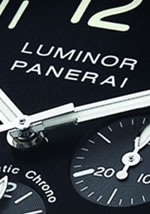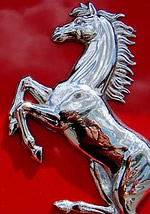 Officine Panerai, a storied Italian watchmaker that in recent years has emerged as one of the most sought-after brands in the industry (and is characterized by its fiercely loyal following of collectors and aficionados), derives much of its legacy from its historical role as the official supplier of the Royal Italian Navy. Its marquee model lineages - the Panerai Radiomir and the Panerai Luminor - were developed expressly in response to the stringent demand requirements of the Italian divers, submariners, and commandos who would be employing them on critical underwater assignments. The brand's military pedigree is reflected in the understated elegance of its austere black faces and luminous Arabic numerals and sticks that make Panerai one of the most iconic brands on the luxury market today.
Officine Panerai, a storied Italian watchmaker that in recent years has emerged as one of the most sought-after brands in the industry (and is characterized by its fiercely loyal following of collectors and aficionados), derives much of its legacy from its historical role as the official supplier of the Royal Italian Navy. Its marquee model lineages - the Panerai Radiomir and the Panerai Luminor - were developed expressly in response to the stringent demand requirements of the Italian divers, submariners, and commandos who would be employing them on critical underwater assignments. The brand's military pedigree is reflected in the understated elegance of its austere black faces and luminous Arabic numerals and sticks that make Panerai one of the most iconic brands on the luxury market today. Founded on the famed Ponte alle Grazie in Florence by Giovanni Panerai in 1860, the predecessor of what would become Officine Panerai was the first watchmaking shop established in the city and from its inception maintained close professional ties with its prestigious counterparts in Switzerland. Under the stewardship of Guido Panerai, the founder's grandson, the enterprise specialized in building precision instruments and by the turn of the century it had been chosen as the Navy's official supplier and moved to a new location on the Piazza San Giovanni (where the flagship Panerai boutique can be found today)
In the first decades of the 20th century Panerai began experimenting intensively with luminous materials in an effort to make instrument dials, sights, and telescopic devices that could be employed reliably in the dark. They settled on a patented combination of zinc sulphide and radium bromide that was later given the name Radiomir. Perfected by Giuseppe Panerai in the 1930s, a prototype Panerai Radiomir wristwatch was submitted to the First Submarine Group of the Royal Italian Navy in 1936 for approval. The watch was hailed for its performance and by 1938 the prestigious Panerai Radiomir was being employed by elite teams of Italian naval commandos in the field.
The Panerai Radiomir first gained the attention of watch enthusiasts during the Second World War as a result of its association with the audacious operations being carried out by Italian divers in the Mediterranean. The most famous of these attacks took place in December of 1941 when a group of six Italian commandos successfully crippled two British battleships, a tanker, and a destroyer in the port of Alexandria, Egypt. The leader of the squad, Lieutenant Luigi Durand De La Penne, was captured during the operation while attempting to save one his men and was subsequently interrogated aboard one of the targeted battleships. Though he refused to disclose the location of the charges he warned the British captain that he would need to evacuate his ship immediately if he wanted to save his crew. De La Penne and his partner were left in the hold while the ship was abandoned and miraculously survived the explosion that crippled the vessel. The British were so impressed by his conduct that he was later recommended for the gold medal of honour; one British admiral went so far as to describe him as 'the deliverer of the greatest blow that a single man has ever inflicted on a fleet.' By the end of the conflict the limited number of Panerai Radiomirs in circulation had become highly sought after collectors items.
In the early 1950s the venerable Panerai Radiomir was accompanied and later replaced by the Panerai Luminor. Although the Luminor preserved the Radiomir's emblematic watch case and dial it also incorporated several design advances including a distinctive bridge with a unique mechanism for locking the crown (the feature is so unique that it is now trademarked by Panerai) and an 8 day power reserve that greatly reduced the frequency with which the crown would need to be wound.
Panerai's wrist watches were reserved exclusively for military clients until the end of the 1980s. Although Panerai began selling directly to the public in the early 1990s, it was only after its 1997 acquisition by the Richemont Group - the same entity that manages the Cartier and IWC brands - that the brand began to garner wide international attention. Seizing upon the enormous potential of the Panerai legacy, Richemount re-introduced the historical Panerai Radiomir and Panerai Luminor models in their manual form and launched its own contemporary collection of automatic watches inspired by the classic lineages. Today Panerai is one of the most coveted and respected brands in the contemporary watchmaking industry. With its distinctive aesthetic identity, compelling historical legacy, and reputation as a brand favored by sophisticated aficionados it is little wonder that the ranks of Paneristi have grown so dramatically around the world.





No comments:
Post a Comment